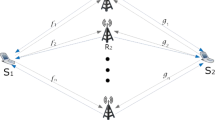Abstract
In this paper, we investigate a robust filter-and-forward (FF) beamforming design for two-waymulti-antenna relaying networks, where multiple relays assist two terminals to exchange information. With Gaussian distributed channel errors, the proposed robust beamforming design aims at maximizing the signal-to-interference-plus-noise-ratio (SINR) under individual transmit power constraints at each relay. Exploiting the elegant convex optimization mathematical tools, the optimization problem can be efficiently solved. Finally, simulation results demonstrate that the proposed robust beamformer reduces the sensitivity of the two-way multi-antenna relay networks to channel estimation errors, and outperforms the algorithm with estimated channels only. Moreover, the length of robust beamformer also influences the system performance.



Similar content being viewed by others
References
Laneman JN, Tse DNC, Wornell GW (2004) Cooperative diversity in wireless networks: efficient protocols and outage behavior. IEEE Trans Inf Theory 50:3062–3080
Kramer G, Gastpar M, Gupta P (2005) Cooperative strategies and capacity theorems for relay networks. IEEE Trans Inf Theory 51:3037–3063
Shen Y, Fei Z, Xing C, Kuang J (2011) Beamforming design for multi-pair two-way AF MIMO relaying networks using quadratic programming. In: Proc IEEE ISCPCC, Xi’an, China, pp 1–5
Li W, Li J, Fan P (2010) Network coding for two-way relaying networks over Rayleigh fading channels. IEEE Trans Veh Technol 59(9):4476–4488
Jing Y, Jafarkhani H (2009) Network beamforming using relays with perfect channel information. IEEE Trans Inf Theory 55:2499–2517
Zhang S, Liew S, Lam P (2006) Physical layer network coding. In: Proc 12th annual international conference on mobile computing and networking (ACM MobiCom 2006)
Ding Z, Leung K, Goeckel D, Towsley D (2009) On the study of network coding with diversity. IEEE Trans Wireless Commun 8(3):1247–1259
Tao M, Zhang R (2012) Robust relay beamforming for two-way relay networks. IEEE Commun Lett 16(7):1052–1055
Havary-Nassab V, Shahbazpanahi S, Grami A (2010) Optimal distributed beamforming for two-way relay networks. IEEE Trans Signal Process 58(3):1238–1250
Zhang R, Liang Y, Chai C, Cui S (2009) Optimal beamforming for two-way multi-antenna relay channel with analogue network coding. IEEE J Sel Areas Comm 27(5):699–712
Gao F, Zhang R, Liang Y (2009) Channel estimation for OFDM modulated two-way relay networks. IEEE Trans Signal Process 57(11):4443–4455
Zhou Y, Wang J, Ng TS, Higuchi K, Sawahashi M (2008) OFCDM: a promising broadband wireless access technique. IEEE Commun Mag 46:39–49
Zhou Y, Wang J, Sawahashi M (2005) Downlink transmission of broadband OFCDM systems—Part I: hybrid detection. IEEE Trans Commun 53(4):718–729
Munoz-Medina O, Vidal J, Agustin A (2007) Linear transceiver design in nonregenerative relays with channel state information. IEEE Trans Signal Process 55:2593–2604
Chen H, Gershman AB, Shahbazpanahi S (2010) Filter-and-forward distributed beamforming in relay networks with frequency selective fading. IEEE Trans Signal Process 58:1251–1262
Liang Y, Ikhleti A, Gerstackertt W, Schobert R (2011) Two-way filter-and-forward beamforming for frequency-selective channels. IEEE Trans Wireless Commun 10:4172–4183
Chen H, Shahbazpanahi S, Gershman AB (2012) Filter-and-forward distributed beamforming for two-way relay networks with frequency selective channels. IEEE Trans Signal Process 60:1927–1941
Liang Y, Ikhleti A, Gerstackertt W, Schobert R (2010) Filter-and-forward beamforming for multiple multiCAntenna relays. In: Proc IEEE CHINACOM’5, pp 1–8
Xing C, Ma S, Wu Y-C (2010) Robust joint design of linear relay precoder and destination equalizer for dual-hop amplify-and-forward mimo relay systems. IEEE Trans Signal Process 58:2273–2283
Xing C, Fei Z, Wu Y-C, Ma S, Kuang J (2011) Robust transceiver design for af mimo relay systems with column correlations. In: Proc IEEE ISCPCC, Xi’an, China, pp 1–6
Havary-Nassab V, Shahbazpanahi S, Grami A, Luo Z (2008) Distributed beamforming for relay networks based on second-order statistics of the channel state information. IEEE Trans Signal Process 56:4306–4316
Quek TQS, Win MZ, Chiani M (2010) Robust power allocation algorithms for wireless relay networks. IEEE Trans Commun 58(7):1931–1938
Boyd S, Vandenberghe L (2004) Convex optimization. Cambridge University Press, Cambridge
Chong EKP, Zak SH (1996) An introduction to optimization. Wiley, New York
Zeng M, Zhang R, Cui S (2011) On design of collaborative beamforming for two-way relay networks. IEEE Trans Signal Process 56:2284–2295
Author information
Authors and Affiliations
Corresponding author
Additional information
This work was supported in part by the National Natural Science Foundation of China (NSFC) under grant No.61101130.
Appendix A
Appendix A
Based on the following expressions, i.e. \(\mathbb {E}\{{\mathbf {X}}{\mathbf {X}}^{\textnormal {H}}\}\), \(\mathbb {E}\{{\mathbf {Y}}{\mathbf {A}}{\mathbf {Y}}^{\textnormal {H}}\}\) and \(\mathbb {E}\{{\mathbf {Y}}{\mathbf {X}}{\mathbf {X}}^{\textnormal {H}}{\mathbf {Y}}^{\textnormal {H}}\}\), the terms with respect to the estimation errors in Eqs. 12, 19, 21 and 24 can be calculated, in which \({\mathbf {X}}\), \({\mathbf {Y}}\), \({\mathbf {A}}\) can be written as
where \({\mathbf {X}}(p,:)\) denotes the pth row of the matrix \({\mathbf {X}}\) and \({\mathbf {A}}(p,p')\) denotes the pth row and the p’th column element of the matrix \({\mathbf {A}}\). In this Appendix, we assume that \(L_{1}=L_{h}(L_{g})\), \(\Omega =M_{R}\) and \(\Psi =N_{R}\).
1.1 A.1 \(\mathbb {E}\{{\textbf {X}}{\textbf {X}}^{\textnormal {H}}\}\)
It is easy to find that
Due to the statistic independence of the channel estimation error and the definitions in Eq. 2 the above equation can be derived as
1.2 A.2 \(\mathbb {E}\{{\mathbf {Y}}{\mathbf {A}}{\mathbf {Y}}^{\textnormal {H}}\}\)
The matrix \({\mathbf {Y}}{\mathbf {A}}\)equals to
Then, the product \({\mathbf {Y}}{\mathbf {A}}{\mathbf {Y}}^{\textnormal {H}}\) is formulated as follows
If \(j=j'\) and \(k=k'\), then \(\mathbb {E}\{x_{j,k}~x_{j',k'}\}=1\), otherwise \(\mathbb {E}\{x_{j,k}~x_{j',k'}\}=0\). Therefore, Eq. 32 can be rewritten as
1.3 A.3 \(\mathbb {E}\{{\mathbf {Y}}{\mathbf {X}}{\mathbf {X}}^{\textnormal {H}}{\mathbf {Y}}^{\textnormal {H}}\}\)
According to the statistic independence of matrix, we can calculate \(\mathbb {E}\{{\mathbf {Y}}{\mathbf {X}}{\mathbf {X}}^{\textnormal {H}}{\mathbf {Y}}^{\textnormal {H}}\}\) by using the results of Eqs. 30 and 33.
Rights and permissions
About this article
Cite this article
Fei, Z., Wang, N., Xing, C. et al. Robust Filter-and-forward Beamforming Design for Two-way Multi-antenna Relaying Networks. Mobile Netw Appl 18, 467–476 (2013). https://doi.org/10.1007/s11036-012-0430-y
Published:
Issue Date:
DOI: https://doi.org/10.1007/s11036-012-0430-y



